South Africa in Brit-Am Bible Codes
Contents:
1. Zebulon, Holland, and the Elders of Cush
2. Cush and the Diamond
3. The Rivers of Cush, Reuben, Gad, and half-Menasseh
4. Reuben, Gad, and the Huegonots.
5. South Africa and Naphtali
6. Gog
7. A Solution for South Africa?
1. Zebulon, Holland, and the Elders of Cush
Brit-Am in general terms relates to South Africa as part of Joseph specifically Ephraim but with Israelites from other Tribes amongst its population. A Bible Code examination on a simple level produced results that in part confirmed previous Brit-Am understanding while opening up additional possibilities. We entered South Africa in the Codes and received no results. South Africa however is part of Africa. The early European settlers of South Africa were Huegeonots from France, Germany, and especially Holland. In our Brit-Am Biblical Codes study of Holland we found a connection between Holland, the Israelite Tribe of Zebulon, and the
ELDERS OF CUSH which we understood to refer to the early "Boer" pioneers of South Africa.
2. Cush and the Diamond
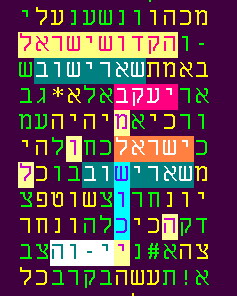
Cush means Africa in general. We could not find anything specific for South Africa BUT South Africa is in Africa ("Cush" in Hebrew though in some cases "Cush" may also refer to India and other regions) and does produce diamonds. The diamond (Yahalom in Hebrew) was the precious stone representing the Tribe of Zebulon in the Breastplate of the High Priest in the Temple Service (Exodus 28:18). If we therefore were to find combinations indicating CUSH (Africa) and YaHaLOM (diamond) overlapping each other they could be significant concerning South Africa since South Africa is the major candidiate to which they could refer.
We entered both words and sought the nearest sequences.
This matrix is from a reverse sequence of 6 for CUSH and of 15 for YaHaLOM (diamond) with the two sequencesoverlapping each other. The word YaHaLOM begins with the Y in the name of God in the Book of Isaiah 10:23 and works backwards going upwards at a diagonal and around at intervals of 15. In its journal it encounters and intersects (together with CUSH words saying twice THE REMNANT SHALL RETURN.
These are the verses the word YaHaLOM intersects:
[Isaiah 10:21] THE REMNANT SHALL RETURN, EVEN THE REMNANT OF JACOB, UNTO THE MIGHTY GOD.
[Isaiah 10:22] FOR THOUGH THY PEOPLE ISRAEL BE AS THE SAND OF THE SEA, YET A REMNANT SHALL RETURN: THE CONSUMPTION DECREED SHALL OVERFLOW WITH RIGHTEOUSNESS.
South Africa and Diamonds
http://www.amnh.org/exhibitions/diamonds/africa.html
Extracts:
The story of diamonds in South Africa begins between December 1866 and February 1867, when 15-year-old Erasmus Jacobs found a transparent stone on his father's farm, on the south bank of the Orange River. Over the next 15 years, South Africa yielded more diamonds than India had in over 2,000 years. This great outpouring of diamonds coincided with depletion of Brazilian deposits and with a great rise in wealth, particularly in the United States, that ensured diamond prices did not fall as they did when Brazil outproduced diamond demand in the 1730s.
In the 1870s and 1880s Kimberley, encompassing the mines that produced 95% of the world's diamonds, was home to great wealth and fierce rivalries, most notably that between Rhodes and Barnato, English immigrants who consolidated early 31-foot-square prospects into ever larger holdings and mining companies. In 1888, Rhodes prevailed and merged the holdings of both men into De Beers Consolidated Mines Ltd., a company that is still synonymous with diamonds. Today South Africa is third in production in terms of value and is likely to stay that way for the foreseeable future.
Gold and Diamonds
http://countrystudies.us/south-africa/66.htm
Extracts:
South Africa's modern history has often been dated from the first commercial mining of diamonds and gold in the 1870s and the 1880s, when the region became a magnet for European investment. Mining in the region predated European arrivals by several centuries... Iron mining and smelting sites in the northeast were used as much as 1,700 years ago; copper was mined south of the Limpopo River more than 1,000 years ago; and historians describe early mining activities in the Witwatersrand (literally, "Ridge of White Waters" in Afrikaans, commonly shortened to Rand) area, which attracted miners from elsewhere in Africa as early as the thirteenth century.
Soon after the European rush for gold and diamonds in the late nineteenth century, mining operations expanded to include more than two dozen other minerals. By the mid-twentieth century, South Africa was the world's largest producer or second largest producer of gold, diamonds, platinum, chromium, manganese, and vanadium; and it ranked high among producers of coal, iron ore, uranium, copper, silver, fluorspar, asbestos, and limestone.
Clusters of minerals occur in five major mineral complexes--the Bushveld, Transvaal, Witwatersrand, Northern Cape, and Western Cape complexes.
Despite its importance in export revenues, the mining industry contributes only about 9.6 percent of GDP in the mid-1990s, down from an average of nearly 15 percent during the 1980s. The mining sector had been gradually surpassed by manufacturing and financial services both in terms of national output and labor force participation. The mines still account for a greater share of export revenues than any other single economic activity in the 1990s.
Gold, first mined by Europeans in 1886 near Johannesburg, soon became the most important sector in the mining industry. South Africa has almost one-half of the world's known gold reserves, located primarily in the Rand in what was once a prehistoric lake. Gold is also mined in the Free State. Industry analysts estimated in the early 1990s that South Africa had produced more than 43,000 tons of gold in the past century, and that at least that amount remained in reserves.
...the [gold] industry has consistently earned high profits and has accounted for one-third to one-half of the world's gold production in the 1980s and 1990s.
Diamonds and Platinum
South Africa's diamond mining industry dates back to 1867, when diamonds were discovered near Kimberley, now in the Northern Cape. The Kimberley diamond fields, and later discoveries in Gauteng, the Free State, and along the Atlantic coast, emerged as major sources of gem-quality diamonds, securing South Africa's position as the world's leading producer in the mid-twentieth century. (Rough diamonds were produced in larger quantities in Australia, Zaire, Botswana, and Russia.)
[i.e. South Africa remains the leading producer of gem quality diamonds as distinct from industrial quality].
South Africa is the world's leading producer of platinum. Its output of about ninety tons in 1993 accounted for almost 49 percent of world production.
3. The Rivers of Cush, Reuben, Gad, and half-Menasseh
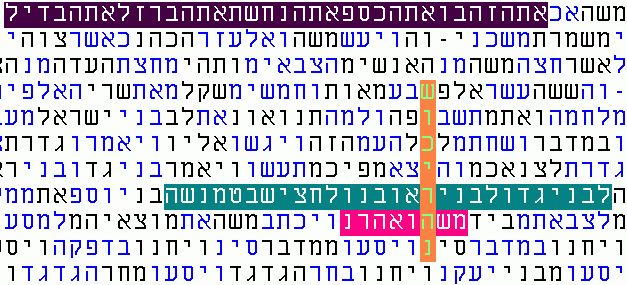
In Prophecy we identified South Africa with the Israelite entity "Beyond the Rivers of Cush".
See
Brit-Am Answers to Queries: South Africa
Q. 1. What do the Prophets say of South Africa and the Boers?
The above matrix is based on THE RIVERS OF CUSH that appears at intervals of 467 going backwards.
At the top, close to the matrix we find the verse:
ONLY THE GOLD, AND THE SILVER, THE BRASS, THE IRON, THE TIN, AND THE LEAD [Numbers 31:22].
South Africa has produced and still produces a good proportion of the gold in the world. It also produces quanities of the metals listed above as well as other minerals some of which in Biblical terminology may be included in the names given above since they belong to the same categories.
Gold was important to South Africa not opnly for its economical importance. Historically, gold brought a flood of immigrants from the nations of Joseph to South Africa lead to wars with the Boers and ultimately to British domination over the whole country.
The matrix intersects the verses and especially the highlighted words below:
[Numbers 32:33] AND MOSES GAVE UNTO THEM, EVEN TO THE CHILDREN OF GAD, AND TO THE CHILDREN OF REUBEN, AND UNTO HALF THE TRIBE OF MANASSEH THE SON OF JOSEPH, THE KINGDOM OF SIHON KING OF THE AMORITES, AND THE KINGDOM OF OG KING OF BASHAN, THE LAND, WITH THE CITIES THEREOF IN THE COASTS, EVEN THE CITIES OF THE COUNTRY ROUND ABOUT.
[Numbers 33:1] THESE ARE THE JOURNEYS OF THE CHILDREN OF ISRAEL, WHICH WENT FORTH OUT OF THE LAND OF EGYPT WITH THEIR ARMIES UNDER THE HAND OF MOSES AND AARON.
4. Reuben, Gad, and the Huegenots
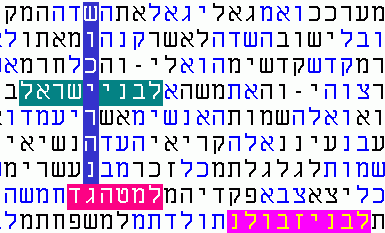
The matrix begins at Leviticus 27:19 and continues to Numbers 1:24 with a reversed sequence of 244.
We saw in the previous example above how the THE RIVERS OF CUSH were intersected by THE CHILDREN OF GAD, AND TO THE CHILDREN OF REUBEN, AND UNTO HALF THE TRIBE OF MANASSEH.
In this example we find THE RIVERS OF CUSH intersected by THE CHILDREN OF ISRAEL with THE TRIBE OF GAD below meaning here at the beginning since the name goes backwards. On the next line down we find the expression FOR THE CHILDREN OF ZEBULON. The association with ZEBULON is obvious since the Boers came predominantly from the Netherlands. The Boers however were also mainly Huegenots the forefathers of whom had fled from France to Holland. France is dominated by Reuben but also contains contingents from Gad and Manasseh. This is explained in "The Tribes" where we also suggest a special connection between the Gothic Hugeonots and the Israelite tribe of Gad that included the clan of Chaggi or Haggi (Numbers 26:15).
The Boers had similar characteristics to the THE CHILDREN OF GAD, AND TO THE CHILDREN OF REUBEN, AND UNTO HALF THE TRIBE OF MANASSEH who according to Scripture had great flocks of sheep and cattle and preferred the open pasture spaces east of the Jordan to the more built up regions west of it (Numbers 32:1-5). So too, the Boers were farmers and grazers. They preferred the wide open spaces. It was said that if a Boer farmer could see the smoke from the chimney of his neighbor on the horizon he would begin to feel crowded and plan to move on. The Boers resented the mainly English-speaking immigrants who came looking for gold and stayed to settle in the towns. A Boer leader is quoted as saying, "God put gold in the ground, let it stay there".
5. South Africa and Naphtali
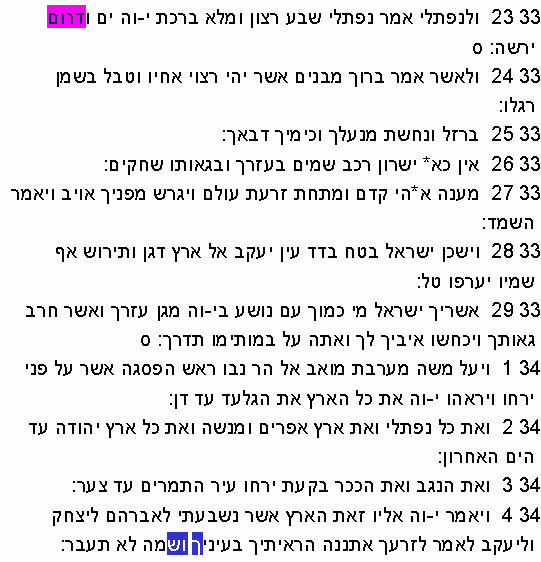
Cush ("Africa") and Drom ("South") were placed separately in the Bible Codes search Engines and the nearest distance between the two was sought. The first two answers dealt with eschatalogical matters and this was the third finding with a distance of 516 letters between the two words. This example concerns Israelite Tribal Identification which is what interests us here. The first word ("Drom") is found in Deuteronomy 33:23 and the second (Cush) in Deuteronomy 34:4.
It begins with,
[Deuteronomy 33:23] AND OF NAPHTALI HE SAID, O NAPHTALI, SATISFIED WITH FAVOUR, AND FULL WITH THE BLESSING OF THE LORD: POSSESS THOU THE WEST AND THE SOUTH [Hebrew: DeROM].
and ends with,
[Deuteronomy 34:4] AND THE LORD SAID UNTO HIM, THIS IS THE LAND WHICH I SWARE UNTO ABRAHAM, UNTO ISAAC, AND UNTO JACOB, SAYING, I WILL GIVE IT UNTO THY SEED: I HAVE CAUSED THEE TO SEE IT WITH THINE EYES, BUT THOU SHALT NOT GO OVER THITHER. In the original text the word order of the end part is:
SEE IT WITH THINE EYES, BUT THITHER THOU SHALT NOT GO OVER
of this phrase the emphasized words are:
SEE IT [WITH THINE EYES, BUT THITHER [Hebrew: "be-AyneC-VeShaMaH" with the colored letters in Hebrew spelling "CUSH"] THOU SHALT NOT GO OVER
Concerning the first words it is interesting what we wrote in "The Tribes" in our caption to the former Coat-of-Arms of the Republic of South Africa:
SOUTH AFRICA: JOSEPH-NAPHTALI-ZEBULON
South Africa was colonized mainly by people of British and Dutch descent with others in addition to the presence of several different African nations. The white peoples are those who (in this case) belong to Israel. The Coat of Arms features a lion (from Joseph -Britain), and two deer (a springbox and oryx). The Deer was a symbol of Naphtali of whom it was prophesied that he would be greatly blessed and receive the "west and the south " (Deuteronomy 34:23).
We identified Naphtali with elements who settled in Norway including the Naphtalite Huns. In Viking times a migration from Norway to parts of Scotland and Northern Enlgand and Ireland took place. In addition new evidence indicates the presence of elements from Naphtali amongst the so-called "Celtic" peoples of Britain espoecially in Wales. It could be that all these different elements contributed to the "Anglo-Saxon" settlements in South Africa thus fulfilling the expression of Naphtali inheriting the "west and the south " (Deuteronomy 34:23).
6. Gog
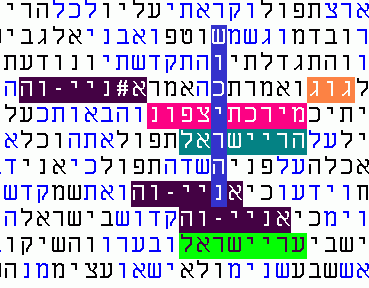
This is taken Ezekiel 39:6 to 38:22 at a reverse interval of 65. The passage speaks about the war of GOG and Magog. We should remember that while we identify the Boers and "Anglos" of South Africa as
basically of Israelite origin other elements also exist. In the case of South Africa these "other" non-Israelite elements have come to the fore on several occasions and should be recognized for who they are. Brit-Am has established Criteria for determining who belongs to Israel and who does not and anyone who is anti-Jewish is suspect of not belonging.
In the matrix above THE RIVERS OF CUSH intersect FROM THE THIGHS [peninsulas] OF THE NORTH (translated in the KJ as "OF THE NORTH QUARTERS" (Ezekiel 38:6) and the Israelite settlers of South Africa did arrive from such regions. After that we have an intersection with MOUNTAINS OF ISRAEL and further down CITIES OF ISRAEL. We also find the NAMES OF GOD intersecting the beginning and close by which along with other signs emphasizes the deep religious nature and spiritual potential that the Hebrews of South Africa possess.
7. A Solution for South Africa?
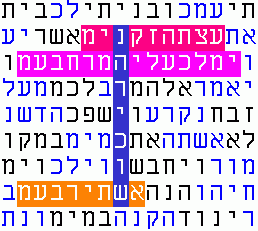
This appears to be the last Equidistant Letter Sequence (ELS) in the Bible forming the combination RIVERS OF CUSH. It is a reverse sequence of 720. It is derived from 1-Kings 12:8 onwards which speaks of the DIVISION between Judah and Israel, how Judah made REHOBOAM THEIR KING and how the WIFE OFJEROBOAM went to seek advice from the Prophet concerning her son. The sequence starts with Rehoboam rejecting THE ADVICE OF THE ELDERS. We saw above the link to THE ELDERS OF CUSH who in turn are linked to THE ELDERS OF THE CITY in Israel. It could be that the Israelites of South Africa should draw closer both to their own spiritual past heritage bequeathed to them by their ELDERS as well as endeavoring to heal the breach between Joseph and Judah?
More
Brit-Am Articles
on the Bible Codes
For More on Brit-Am Bible Codes
including General Information along with
results from specific nations go to:
Bible Codes and Brit-Am:
List of Articles
Join the Brit-Am Ephraimite
Discussion Group
Just Send an
e-mail
with "Subscribe"
in the Subject Line
Main Page
Offerings and Publications







